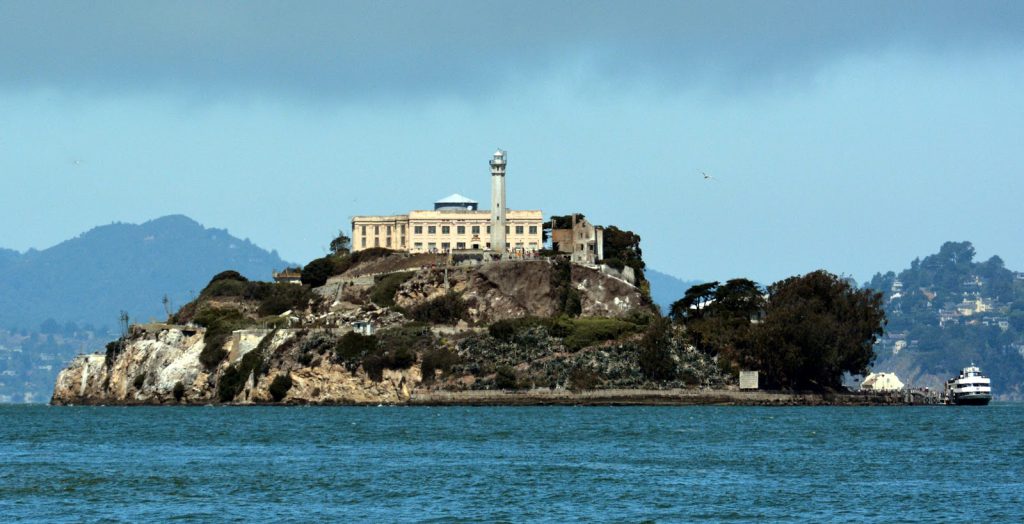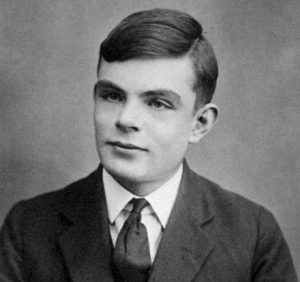Winner of the Fall 2019 StMU History Media Award for
Best Use of Images
It’s the summer of 1962. Off the coast of San Francisco stands a very high profile penitentiary known as Alcatraz. Alcatraz was home to America’s most dangerous criminals, and stands as its own in San Francisco Bay. Although this island was known for its top notch security, the island was put to a rather challenging test on the night of June 11, 1962. Three men by the names of John Anglin, Clarence Anglin, and Frank Morris seemed to have had the guts to risk the penitentiary’s high profile reputation, and escape the inescapable.
Established in 1934, Alcatraz was known as the first super-maximum facility to implement high-level security for the nation’s most notorious criminals. This meant that it was the first prison constructed to hold prisoners that needed to be separated from others due to the threats they impose on fellow inmates. During the 1930’s, there was a drastic increase in crime from the effects of the Great Depression, which caused America’s economic and social climate to fall. Because of this, Alcatraz was without a doubt a necessity to hold American monsters.1 The prison held up to 600 inmates, yet the population only averaged 204. Inmate’s were given the very minimum for survival: shelter, clothing, medical care, and food. Prison cells were five feet by nine feet with each containing a bed, toilet, sink, and desk. Daily activities included body counts conducted several times a day, and working five days a week and eight hours a day. It was required that all inmates be up by 7:30 am and asleep by 9:00 pm. Although these criminals undoubtedly got what they deserved, they were given privileges, such as personal correspondence or library access if the prison guards thought they deserved it. A bright side to being an Alcatraz inmate was the privacy and reduced violence compared to other penitentiaries of its time.2

Frank Morris and the Anglin Brothers had been some of the top-wanted criminals of their time, yet they didn’t start their lives being destined for Alcatraz. As a child, Frank Morris was a foster child who moved from foster home to foster home. The Anglin brothers were farmers who worked for their father growing up, constantly causing problems in school. Since all three of the men had troubled past, it makes sense why they became the criminals of their inevitable future. The trio of criminals were all originally most known for robbing banks, leading to the brothers going in the Atlanta Penitentiary, and Morris in the Louisiana State Penitentiary. Morris was a very capable and smart individual. During his time in Louisiana, he successfully escaped his penitentiary. Additionally, during the brothers’ time in Atlanta, they piled on many failed escape attempts. After Morris was eventually found by the police and the brothers could not learn their lesson, all three were sent to the famous island of Alcatraz.3
The men first met each other in Alcatraz, and started to plan their escape on a cold night in December of 1961. Behind their cells ran a three foot wide tunnel they hand-chipped away over a period of time, using homemade tools such as a silver spoon from a dime and a drill made from an old vacuum cleaner. The men concealed the progress of their tunnels with walls of painted cardboard. When drilling through the cement wall, Morris played loud accordion music to conceal the noise. Their efforts of drilling and chipping ultimately led to an undetected utility corridor they reached by climbing pipes. This utility corridor became their “lab” for putting together all the pieces of their plan, metaphorically and physically. Metaphorically, they met up in this spot to devise their plan of all the specific details. Physically, the escapees spent numerous weeks constructing an inflatable raft and life vests out of stolen prisoner raincoats. To trick the guards the night of their escape, they created paper mache dummy heads to work as a clone for each prisoner after they left their cells to escape.4

Finally, on the night of June 11, 1962, the men set off to escape. Another prisoner by the name of Allen West was in on the escape plan as well. However, he was trapped in his cell the night of the escape after realizing the cement inside his vent had crumbled and hardened, preventing the grill from opening. Once he was able to remove the grill, he came to find that the other prisoners had already escaped without him, and so he eventually returned to his cell to go to sleep. From the utility corridor, Morris and the Anglin brothers climbed a ventilation shaft to reach the roof. While attempting to get to the roof, the guards heard a loud crash as they broke out of the shaft. Thankfully for the men, the guards did not further investigate, because they never heard any noises following. Dragging their gear with them, they eventually climbed down a fifty foot vent pipe to get to the ground, then climbed two twelve-foot barbed-wire fences, and landed on the island’s shoreline. On the northeastern side of the island near a power plant was a blind spot in the prison’s system of gun towers and searchlights. Around 10:00 p.m., the prisoners then inflated their homemade raft, and set off for Angel Island, which was about two miles north of Alcatraz. This monumental escape was unnoticed until the next morning, when the lights flashed on. The prison was then in a panic, with guards searching everywhere to hunt down the prisoners. However, by this time it was too late. The inmates were nowhere to be found.5
The FBI considered the case of the escaped prisoners a very serious matter. Alcatraz was America’s top security penitentiary at the time, and escape could possibly embarrass the government. In addition, the penitentiary had held monstrous criminals such as Al Capone, George ‘Machine Gun’ Kelly and Alvin Karpi, therefore escape by one criminal could lead to public worry of escapes by multiple criminals.6 After investigation, the FBI declared Morris and the Anglin brothers dead due to drowning. They stated that although the mile long swim to Angel Island would be possible, the strong currents and frigid Bay water would put the odds extremely against the men’s survival. According to Allen West, the fourth man involved in the escape, the plan was to steal clothes and a car once arriving on land. However, there were no thefts or suspicious activities detected in the area at the time, further leading to the conclusion that they never made it to land. The families of the prisoners were slightly suspected to have aided the men afterwards, yet it was highly unlikely due to the fact the families were barely financially viable. For seventeen years, the FBI investigated this case without any credible evidence emerging that would have suggested that the men were still alive in the United States, or internationally. The case was officially closed on December 31, 1979, and was turned over to the United States Marshals Service.7

Although the FBI believed the odds of their survival were slim, the bodies were never recovered, leaving it a mystery as to whether they drowned in the frigid waters of San Francisco Bay, or made it to land safely. In 2013, a letter was sent to the police that claimed that the criminals were in fact breathing and alive. “I escape[d] from Alcatraz in June 1962 with my brother Clarence and Frank Morris. I’m 83 years old and in bad shape. I have cancer. Yes we all made it that night but barely!”8 However, this letter was not released to the public until January of 2018, because it had to be kept under wraps for the investigation. The letter explained that John was the last living of the trio, and offered a deal that if he were provided medical care for his cancer, in exchange he would turn himself in to the authorities, but only if they agreed to an additional one year in prison. The FBI did not cooperate, and alternatively repressed the letter. Despite the fact of this letter and other rumors about the successful escape having been introduced to the public, an interview with the Marshals who took over the investigation after the FBI was conducted and televised by CBS San Francisco. The Marshals told the broadcaster, “The Federal Bureau of Prisons say that they drowned once they got off of Alcatraz and their bodies were swept out to the Pacific Ocean—end of story.”9
In 1963, Alcatraz permanently closed, a year after the trio escaped. It did not close because of the disappearance of the prisoners, but because the facility was too costly to operate. It was said $3-5 million was needed for maintenance and to keep the prison open, not including daily operating costs. At the time, it was three times more expensive to run than any other penitentiary in the United States. Since the Island had no fresh water, close to one million gallons of water had to be transported to the island by boat each week. Therefore, the Federal government concluded, it was more reasonable to construct a new institution rather than keep Alcatraz open.10
Now the famous institution hosts more than a million tourists a year, often fascinated by the story of Morris and the Anglin brothers. In fact, there was a 1979 film starring Clint Eastwood Escape From Alcatraz about this very story. One of the most popular attractions in the prison is John Anglin’s cell, from where the men made their run for it. The scene is conserved almost perfectly, with the exact hole in the wall from which he escaped. Nonetheless, even the scene of the crime provides very few answers as to where the escapees ended up.11
Working together to achieve the impossible not only worked against America’s most secure prison, but caused an uproar around the globe. The case remains one of the most famous mysteries in the history of the United States, and will continue to be wondered upon for years to come. After all these years, we can’t help but speculate whether or not the men still walk among us today.
- Deborah Hopkinson, “Escape From ALCATRAZ,” Scholastic Action 36, no. 4 (2012): 8-11. ↵
- History Editors, “Alcatraz,” History, June 7, 2019, https://www.history.com/topics/crime/alcatraz. ↵
- Steve Boisson, “The Rock,” Civil War Times 41, no. 5 (2002): 21. ↵
- Robert D. McFadden, “Tale of 3 Inmates Who Vanished From Alcatraz Maintains Intrigue 50 Years Later,” The New York Times, June 9, 2012, https://www.nytimes.com/2012/06/10/us/anniversary-of-a-mystery-at-alcatraz.html. ↵
- “Alcatraz Escape,” FBI History, https://www.fbi.gov/history/famous-cases/alcatraz-escape. ↵
- Jane Fryer, “Is this the proof two audacious crooks did escape from Alcatraz?” Daily Mail (website), October 14, 2015. Accessed May 2, 2018. http://www.dailymail.co.uk/news/article-3271521/Is-proof-two-auspicious-crooks-DID-escape-Alcatraz.html. ↵
- “Alcatraz Escape,” FBI History, https://www.fbi.gov/history/famous-cases/alcatraz-escape. ↵
- Natasha Frost, “Was the Escape from Alcatraz Successful? Exploring New Evidence,” History, August 31, 2018, https://www.history.com/news/alcatraz-escape-new-evidence-anglin-brothers. ↵
- Natasha Frost, “Was the Escape from Alcatraz Successful? Exploring New Evidence,” History, August 31, 2018, https://www.history.com/news/alcatraz-escape-new-evidence-anglin-brothers. ↵
- Don Siegel, Richard Tuggle, Clint Eastwood, Patrick McGoohan, Roberts Blossom, Jack Thibeau, Fred Ward, Paul Benjamin, Larry Hankin, and J. Campbell Bruce, Escape from Alcatraz, 1999; Hollywood, CA: Paramount Pictures, 1999. Widescreen DVD Collection. ↵
- Natasha Frost, “Was the Escape from Alcatraz Successful? Exploring New Evidence,” History, August 31, 2018, https://www.history.com/news/alcatraz-escape-new-evidence-anglin-brothers. ↵



68 comments
Juan Arceo
Alcatraz was one of the most secure prisons to be in and even then 3 people were still able to escape. This event reminds me of an event that happened sooner relating to El Chapo, and how he was able to escape from an equally secured prison. It amazes me that there are people out there that ultimately sacrifice their lives to escape from a place that they were sent to based on their actions.
Trinity Casillas
I didn’t know about all the thought and clever ideas that went into the escape beforehand so that was interesting to learn about. It seems like the letter from the remaining brother wasn’t taken very seriously because of pride. That’s a little frustrating and confusing to me but perhaps since I am not an FBI agent, it doesn’t make sense to me.
Kathryn Martinez
Before reading this article I had plenty of background information regarding the Alcatraz escape, however, this article still was able to surprise me with new details regarding the event and was very informational. The general idea of the escape amazes me especially with the odd behavior of the inmates and noises that could be heard. But what is even more strange is the fact no one currently truly knows what happened to the inmates. Great article!
Nicholas Hatch
Before reading this article, I had very little knowledge of Alcatraz. Now I had never heard of this escape but this article did a good job of explaining it. It is very crazy that Alcatraz being a high maximum security prison never suspected that these three men would actually have something planned even when seeing their odd behavior. This was a very good article!
Malik Heard
I think everyone that has heard of a prison break has heard of Alcatraz because it was said to be impossible to escape yet three criminals were able to somehow mange.It was supposed to be four but the last one couldn’t get out of his cell in time for the escape. The escape is one of the most interesting prison breaks because we never knew if they all got out alive or not.But it turns out maybe they did if the letter was real.
Sebastian Portilla
Alcatraz is easily one of the most difficult prisons to escape from. If you are able to escape your cell and the guards, you then have to swim back to land, by then authorities are already waiting for you. Its almost an impossible situation, I don’t know how these men did it. Its kind of cool to learn that 3 men did escaped the impossible.
Pablo Ruiz
I have always heard of Alcatraz as being the most secure prison in the United States. I find it fascinating that these men were able to chip away their cell walls and create a successful plan for escape. Even if they really had drowned the escape they pulled off was still impressive. I think it is possible that the men did successfully escape because of the raft they made and no bodies were ever discovered from the water.
Mark Dominguez
This was a very interesting and informative article. Prior to reading this, I had of course heard about the notoriously inescapable Alcatraz, but I never knew that three men had managed to get away with it. It is bizarre to read about what these men had to do to escape, such as making a raft and life jackets with their limited resources. It is baffling that no one found them after they escaped.
Elizabeth Maguire
Congrats on the nomination! I had visited Alcatraz during spring break in 2019. I found it interesting that people thought that nothing would go wrong or have anybody escape the maximum security prison like Alcatraz. Great job on the article.
Kimberly Parker
I remember briefly hearing the name Alcatraz, but never quite knew what it was until I was older. Once I actually knew it was a prison, I figured that this article had to be about prisoners escaping. But the details of this article are very fascinating. I mean, not one but three prisoners were able to escape, which is a fact that is hard to wrap my head around due to not only the conditions of the prison but the weather and location of it as well. It’s honestly kind of scary that three men were able to escape a prison that was said to be inescapable.